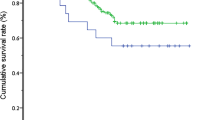Abstract
Purpose
Apparently superior result was observed after open Kasai portoenterostomy in infant with biliary atresia. Our institute stopped performing laparoscopic portoenterostomy since 2007. We aimed to investigate the outcome after reintroduction of open portoenterostomy.
Methods
27 non-syndromic infants underwent open Kasai portoenterostomy from 2007 to 2012. The age and the sex of the patient, the bilirubin level before the operation, the early clearance of jaundice (total bilirubin <20 μmol/L within 6 month of portoenterostomy), the native liver survival at 2 years after the operation were reviewed. The results were retrospectively compared with all 16 infants who underwent laparoscopic Kasai portoenterostomy before 2007.
Results
All infants had type III biliary atresia. No statistical difference was observed regarding the age at operation and the pre-operative bilirubin level. The early clearance of jaundice rate was 81 % (22/27) after open operation and was 50 % (8/16) after laparoscopic operation (p = 0.03). At 2 years after the operation, the native liver survival was 81 % (22/27) after open operation and was 50 % (8/16) after laparoscopic operation (p = 0.03).
Conclusion
Reintroduction of open Kasai portoenterostomy was associated with superior early clearance of jaundice rate and 2-year native liver survival rate.

Similar content being viewed by others
References
Hartley JL, Davenport M, Kelly DA (2009) Biliary atresia. Lancet 14 374(9702):1704–1713
Kasai M, Suzuki S (1959) A new operation for ‘‘non-correctable’’ biliary atresia: hepatic portoenterostomy. Shujjutsu 13:733
Esteves E, Clemente Neto E, Ottaiano Neto M et al (2002) Laparoscopic Kasai portoenterostomy for biliary atresia. Pediatr Surg Int 18:737–740
Lee H, Hirose S, Bratton B et al (2004) Initial experience with complex laparoscopic biliary surgery in children: biliary atresia and choledochal cyst. J Pediatr Surg 39:804–807
Martinez-Ferro M, Esteves E, Laje P (2005) Laparoscopic treatment of biliary atresia and choledochal cyst. Semin Pediatr Surg 14:206–215
Aspelund G, Ling SC, Ng V et al (2007) A role for laparoscopic approach in the treatment of biliary atresia and choledochal cysts. J Pediatr Surg 42:869–872
Dutta S, Woo R, Albanese CT (2007) Minimal access portoenterostomy: advantages and disadvantages of standard laparoscopic and robotic techniques. J Laparoendosc Adv Surg Tech A 17:258–264
Liem NT, Son TN, Quynh TA et al (2010) Early outcomes of laparoscopic surgery for biliary atresia. J Pediatr Surg 45:1665–1667
Chan KW, Lee KH, Mou JW et al (2011) The outcome of laparoscopic portoenterostomy for biliary atresia in children. Pediatr Surg Int 27:671–674
Nio M, Ohi R, Miyano T et al (2003) Five- and 10-year survival rates after surgery for biliary atresia: a report from the Japanese Biliary Atresia Registry. J Pediatr Surg 38:997–1000
Chan KW, Lee KH, Tsui SY et al (2012) Laparoscopic versus open Kasai portoenterostomy in infant with biliary atresia: a retrospective review on the 5-year native liver survival. Pediatr Surg Int 28(11):1109–1113
Wang B, Feng Q, Ye X et al (2014) The experience and technique in laparoscopic portoenterostomy for biliary atresia. J Laparoendosc Adv Surg Tech A
Ure BM, Kuebler JF, Schukfeh N et al (2011) Survival with the native liver after laparoscopic versus conventional Kasai portoenterostomy in infants with biliary atresia: a prospective trial. Ann Surg 253:826–830
Wong KK, Chung PH, Chan KL et al (2008) Should open Kasai portoenterostomy be performed for biliary atresia in the era of laparoscopy? Pediatr Surg Int 24:931–933
Laje P, Clark FH, Friedman JR et al (2010) Increased susceptibility to liver damage from pneumoperitoneum in a murine model of biliary atresia. J Pediatr Surg 45:1791–1796
Koga H, Miyano G, Takahashi T et al (2011) Laparoscopic portoenterostomy for uncorrectable biliary atresia using Kasai’s original technique. J Laparoendosc Adv Surg Tech A 21(3):291–294
Yamataka A (2013) Laparoscopic Kasai portoenterostomy for biliary atresia. J Hepatobiliary Pancreat Sci 20(5):481–486
Toyosaka A, Okamoto E, Okasora T et al (1994) Extensive dissection at the porta hepatis for biliary atresia. J Pediatr Surg 29(7):896–899
Conflict of interest
Drs. Kin Wai E. Chan, Kim Hung Lee, Hei Yi V. Wong, Siu Yan B. Tsui, Yuen Shan Wong, Kit Yi K. Pang, Jennifer Wai Cheung Mou, Yuk Him Tam have no conflicts of interest or financial ties to disclose.
Author information
Authors and Affiliations
Corresponding author
Rights and permissions
About this article
Cite this article
Chan, K.W.E., Lee, K.H., Wong, H.Y.V. et al. From laparoscopic to open Kasai portoenterostomy: the outcome after reintroduction of open Kasai portoenterostomy in infant with biliary atresia. Pediatr Surg Int 30, 605–608 (2014). https://doi.org/10.1007/s00383-014-3499-5
Accepted:
Published:
Issue Date:
DOI: https://doi.org/10.1007/s00383-014-3499-5




